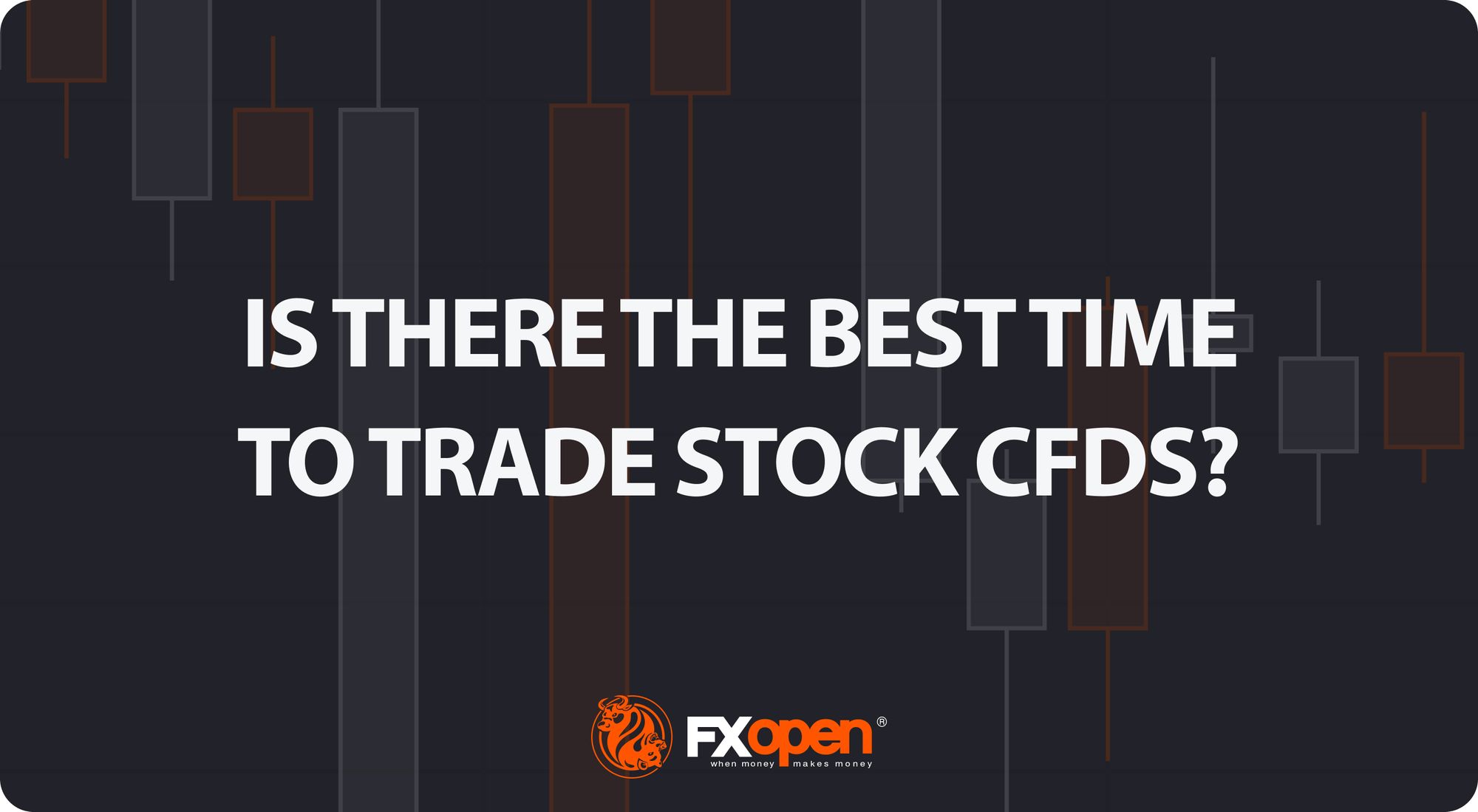FXOpen

If you ask experienced traders, many will say that they trade on certain days or at certain times of the day. Their choice is determined by the market dynamics, volatility, and liquidity. It’s crucial to understand when the best time of the day, week, and month to trade stocks may be. This FXOpen article delves into the intricacies of timing, which may help traders optimise their strategies for greater effectiveness.
Is There the Best Time to Day Trade?
The operational hours of stock markets vary according to their respective time zones, resulting in differing opening and closing times. For example, the US stock market opens at 9:30 and closes at 16:00 local time, while the UK market opens at 8:00 and closes at 16:30 local time.
The theory states that to identify potentially the best time frame for day trading, many traders break the day into four blocks, such as the opening bell, mid-morning, lunch hour, and afternoon, and look at the advantages and challenges that each timeframe presents.
Opening Bell
The opening bell sets the tone for the day, marking the beginning of market activity. As the market opens, there is a surge in trading activity. Traders react to overnight news, economic reports, and pre-market movements. The opening bell often brings increased volatility and liquidity.
Many traders believe the opening bell may be the best time of day to buy stocks if positive news is released after the market closes. Some traders prefer scalping because short-term price fluctuations offer numerous entry and exit points.
However, high volatility brings increased risks. Adjusting position sizes and using appropriate risk management strategies are critical during this period.
Midday
At midday, volatility tends to decrease. Midday trading usually exhibits more consistent patterns compared to the opening or the final hours of the day. Some traders prefer to rely on technical analysis and historical data to identify trends.
This part of the day is commonly used for planning, given that a substantial portion of the day's news has already been incorporated into stock prices, so traders analyse markets and try to identify future trends.
Lunch Hour
The lunchtime lull is characterised by a decrease in trading activity. But if your lunch is earlier or later, it’s essential to adapt your trading strategy to this reduced activity. With lower trading volume, executing large trades becomes more challenging.
Strategies for handling low activity may involve adopting longer timeframes or refraining from aggressive trading. Some traders adjust position sizes and become more cautious when entering the market to avoid significant slippage.
Afternoon
Some traders use the afternoon as the best time to sell stocks during the day if the price of the stock has risen. They sell it and go to bed without worrying about a drawdown during the night. And if this happens, they can buy the stock again in the morning at a lower price.
Late-day trends and reversals may offer favourable opportunities for swing traders. They can capitalise on price movements by holding positions overnight. Effective position management, including setting appropriate stop-loss and take-profit levels, is critical with this strategy.
Trading on the TickTrader platform, you will have access to accurate price data and comprehensive charts with numerous technical tools that may help you decide what to do with a particular stock (buy, sell, or hold).

What Days Traders Usually Trade Stocks
Moving to a larger scale, it is important to decide which days of the week you are going to trade. Remember that there is no specific best day of the month to buy or sell stocks because the decision to trade depends on market trends, economic conditions, and individual company performance.
Monday
There may be events or news over the weekend that affect market sentiment. Traders react to the weekend news when the markets open on Monday. This is why Mondays see more volatility than other days of the week. Additionally, institutional investors make significant trades at the beginning of the week based on their analysis of weekend news.
Just like the first few hours after opening, the first day of the week may be more appropriate for scalping and news-based trading. However, this depends on current market conditions. Traders consider economic indicators, company fundamentals, and the most recent news.
Midweek (Tuesday to Thursday)
The middle of the week usually provides consistency, giving room for strategic trading. Tuesday, Wednesday, and Thursday trading may have a more stable rhythm than the beginning and end of the week.
Traders take advantage of well-established price trends. It may be easier to find patterns and trends at this time. Nevertheless, traders always remain alert to mid-week news and events.
Friday
On Fridays, traders and investors tend to close positions before the weekend. They may sell their assets on Friday to lock in potential returns before the weekend. Additionally, some traders believe that it’s a good day to buy stocks that have dropped in price earlier in the week. Closing or adjusting positions on Fridays is a common practice to reduce the risk of potential gaps over the weekend. Risk management tools are widely used as the market may open with gaps after the weekend. Evaluating risk tolerance is a crucial step for traders around the globe to consider.
However, not all market participants choose a single day for trading. They believe that there are the best stocks for day-to-day trading.
Is There the Best Month to Trade Stocks?
Historically, the best months to trade in the stock market have been October, November, and December. This is because these months tend to have higher trading volumes and more positive market performance due to end-of-year financial reporting and holiday shopping.
Still, there are three key points that are associated with trading opportunities in different months.
- Seasonal trends. Historical patterns show that specific sectors tend to outperform or underperform in certain months. Seasonal fluctuations can affect sectors in different ways – changes may be different in the agro-industry, tourism, and manufacturing.
- Earnings season. The earnings calendar becomes a critical tool during the earnings season. Traders plan their strategies around key earnings announcements, as these events can trigger significant market movements.
- Year-end trading. Market participants often reassess their portfolios towards year-end, considering tax implications and making strategic adjustments. Rebalancing portfolios at the close of the year is a common practice.
Final Thoughts
Trading stocks on a specific day of the week or during certain hours doesn’t guarantee returns, as the stock market’s behaviour is influenced by various factors, and past performance does not necessarily indicate future results. However, there are patterns that are seen in the market year after year, and trading at certain times of the day or day of the week can be justified.
If you are interested in trading stocks via CFDs, open an FXOpen account. FXOpen offers a gateway to the dynamic world of CFDs, allowing you to trade with tight spreads and commissions from $1.
This article represents the opinion of the Companies operating under the FXOpen brand only. It is not to be construed as an offer, solicitation, or recommendation with respect to products and services provided by the Companies operating under the FXOpen brand, nor is it to be considered financial advice.






